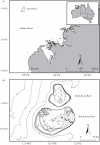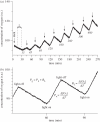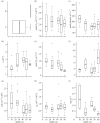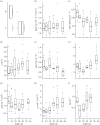Niche specialization of reef-building corals in the mesophotic zone: metabolic trade-offs between divergent Symbiodinium types
- PMID: 21106586
- PMCID: PMC3097838
- DOI: 10.1098/rspb.2010.2321
Niche specialization of reef-building corals in the mesophotic zone: metabolic trade-offs between divergent Symbiodinium types
Abstract
The photobiology of two reef corals and the distribution of associated symbiont types were investigated over a depth gradient of 0-60 m at Scott Reef, Western Australia. Pachyseris speciosa hosted mainly the same Symbiodinium C type similar to C3 irrespective of sampling depth. By contrast, Seriatopora hystrix hosted predominantly Symbiodinium type D1a or D1a-like at shallow depths while those in deeper water were dominated by a Symbiodinium C type closely related to C1. The photosynthesis/respiration (P/R) ratio increased consistently with depth at the two sampling times (November 2008 and April 2009) for P. speciosa and in November 2008 only for S. hystrix, suggesting a reduction in metabolic energy expended for every unit of energy obtained from photosynthesis. However, in April 2009, shallow colonies of S. hystrix exhibited decreased P/R ratios down to depths of approximately 23 m, below which the ratio increased towards the maximum depth sampled. This pattern was mirrored by changes in tissue biomass determined as total protein content. The depth of change in the direction of the P/R ratio correlated with a shift from Symbiodinium D to C-dominated colonies. We conclude that while photobiological flexibility is vital for persistence in contrasting light regimes, a shift in Symbiodinium type may also confer a functional advantage albeit at a metabolic cost with increased depth.
Figures





Similar articles
-
Symbiodinium genotypic and environmental controls on lipids in reef building corals.PLoS One. 2011;6(5):e20434. doi: 10.1371/journal.pone.0020434. Epub 2011 May 26. PLoS One. 2011. PMID: 21637826 Free PMC article.
-
Sharing the slope: depth partitioning of agariciid corals and associated Symbiodinium across shallow and mesophotic habitats (2-60 m) on a Caribbean reef.BMC Evol Biol. 2013 Sep 23;13:205. doi: 10.1186/1471-2148-13-205. BMC Evol Biol. 2013. PMID: 24059868 Free PMC article.
-
The role of deep reefs in shallow reef recovery: an assessment of vertical connectivity in a brooding coral from west and east Australia.Mol Ecol. 2011 Apr;20(8):1647-60. doi: 10.1111/j.1365-294X.2011.05050.x. Epub 2011 Mar 16. Mol Ecol. 2011. PMID: 21410573
-
Symbiodinium-invertebrate symbioses and the role of metabolomics.Mar Drugs. 2010 Sep 30;8(10):2546-68. doi: 10.3390/md8102546. Mar Drugs. 2010. PMID: 21116405 Free PMC article. Review.
-
Coral-the world's most diverse symbiotic ecosystem.Mol Ecol. 2015 Nov;24(21):5330-47. doi: 10.1111/mec.13400. Epub 2015 Oct 21. Mol Ecol. 2015. PMID: 26414414 Review.
Cited by
-
Gene expression signatures of energetic acclimatisation in the reef building coral Acropora millepora.PLoS One. 2013 May 9;8(5):e61736. doi: 10.1371/journal.pone.0061736. Print 2013. PLoS One. 2013. PMID: 23671571 Free PMC article.
-
Depth specialization in mesophotic corals (Leptoseris spp.) and associated algal symbionts in Hawai'i.R Soc Open Sci. 2015 Feb 4;2(2):140351. doi: 10.1098/rsos.140351. eCollection 2015 Feb. R Soc Open Sci. 2015. PMID: 26064599 Free PMC article.
-
Altered Immune Landscape and Disrupted Coral-Symbiodinium Symbiosis in the Scleractinian Coral Pocillopora damicornis by Vibrio coralliilyticus Challenge.Front Physiol. 2019 Apr 2;10:366. doi: 10.3389/fphys.2019.00366. eCollection 2019. Front Physiol. 2019. PMID: 31001143 Free PMC article.
-
Octocorals in the Gulf of Aqaba exhibit high photosymbiont fidelity.Front Microbiol. 2022 Nov 25;13:1005471. doi: 10.3389/fmicb.2022.1005471. eCollection 2022. Front Microbiol. 2022. PMID: 36504779 Free PMC article.
-
Evaluating coral trophic strategies using fatty acid composition and indices.PLoS One. 2019 Sep 11;14(9):e0222327. doi: 10.1371/journal.pone.0222327. eCollection 2019. PLoS One. 2019. PMID: 31509600 Free PMC article.
References
-
- Van Oppen M. J. H., Baker A. C., Coffroth M. A., Willis B. L. 2009. Bleaching resistance and the role of algal endosymbionts. In Coral bleaching: patterns, processes, causes and consequences. Ecological studies, vol. 205 (eds Van Oppen M. J. H., Lough J. M.), pp. 83–102 Berlin, Heidelberg, Germany: Springer
-
- Baird A. H., Bhagooli R., Ralph P. J., Takahashi S. 2009. Coral bleaching: the role of the host. Trends Ecol. Evol. 24, 16–2010.1016/j.tree.2008.09.005 (doi:10.1016/j.tree.2008.09.005) - DOI - DOI - PubMed
-
- Fitt W. K., et al. 2009. Response of two species of Indo-Pacific corals, Porites cylindrica and Stylophora pistillata, to short-term thermal stress: the host does matter in determining the tolerance of corals to bleaching. J. Exp. Mar. Biol. Ecol. 373, 102–11010.1016/j.jembe.2009.03.011 (doi:10.1016/j.jembe.2009.03.011) - DOI - DOI
-
- Rowan R., Knowlton N., Baker A., Jara J. 1997. Landscape ecology of algal symbionts creates variation in episodes of coral bleaching. Nature 388, 265–26910.1038/40843 (doi:10.1038/40843) - DOI - DOI - PubMed
-
- Lesser M. P., Slattery M., Leichter J. J. 2009. Ecology of mesophotic coral reefs. J. Exp. Mar. Biol. Ecol. 375, 1–810.1016/j.jembe.2009.05.009 (doi:10.1016/j.jembe.2009.05.009) - DOI - DOI
Publication types
MeSH terms
Associated data
- Actions
- Actions
- Actions
- Actions
- Actions
- Actions
- Actions
- Actions
- Actions
- Actions
LinkOut - more resources
Full Text Sources
Research Materials
Miscellaneous

